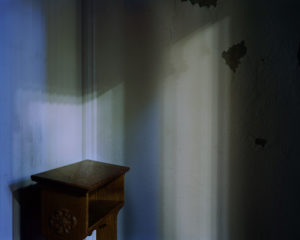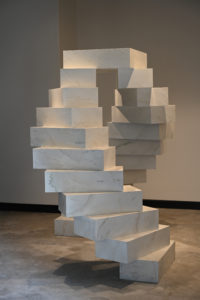Preeti Vasudevan is an award-winning choreographer, performer, educator, and exponent of classical Indian dance (Bharatanatyam), creating provocative contemporary works from the Indian tradition. Founder and artistic director of the performing arts collaborative Thresh, she received a 2021 residency commission from Works & Process at the Guggenheim.
Image: How has your religious and cultural background formed you as an artist?
Preeti Vasudevan: I grew up in India in a very pluralistic society, in which religion was a celebration of ancestry and heritage, not something exclusive or divisive. I studied in an all-girls Catholic school, singing hymns and reading the New Testament while listening to the calls to prayer from nearby mosques. When I returned home, I would hear Hindu verses and chants coming from my grandmother’s prayer room. This polyphonic backdrop created a deep sense that the human story contains many voices.
Image: Tradition, both religiously and artistically, is often seen as static. Do you think that’s a misconception?
PV: I grew up with my grandparents and great-grandparents, and listening to their stories, wisdom, and humor gave me a profound sense of lineage and connection. This allowed me to view other cultures with openness and curiosity, which shaped my understanding of the art of storytelling. Sampradaya, the Sanskrit word for tradition, means “that which keeps evolving.” So, tradition for me is something that adapts and fuses old and new.
Image: You continue to work across multiple geographic and cultural contexts. Can you talk about some of the ways this has influenced your practice?
PV: Living and working in different cultures has taught me how to view my own culture from an outsider’s perspective, and this has kept me from being too precious or impermeable about my work. I believe artists are concentrated mediums of a community. We absorb the sentiments of the people around us, and through an open channel of sensing and listening, we can create openings for greater empathy, both on an intimate and universal level.
Image: How has the pandemic, with its constraints not only on performing but also touch and proximity, challenged you as choreographer and dancer?
PV: An artist’s role is to awaken all senses so that we are truly alive and active, within ourselves as well as with our environment. Physical connection, especially in the performing arts, is essential for creation. Being forced into the two-dimensional world of video calls has created a deep sense of fragmentation in body and mind.
Space has been another challenge. Without a studio to move in and express emotions, without connecting to others through performance, I found my confidence and self-worth challenged. While we created many digital works, I felt a deep void and a sense of isolation. It proved one of the biggest challenges I have faced in my life so far. Touch transmits unspoken messages and is a great healing tool. Without touch, healing from the traumas of this past year has been even harder, and it’s a void we need to refill soon.

Preeti Vasudevan. Stories by Hand, 2017. Dance performance. Photo: Maria Baranova.
Image: During the pandemic, you have been working with indigenous students in Montana as part of your First Voices project. Can you talk a bit about that?
PV: I wanted to reach the youth in Lame Deer on the Northern Cheyenne Reservation in a way that seemed long-lasting. When I look back at what is enduring in my life, it’s usually connection to my roots and ancestry, especially through the stories of my elders. That’s something I can always reach out to when I am lost or alone. While local organizations are doing a lot of work on reservations, there remains an acute need for this kind of connection, especially with the socioeconomic struggles and the loss of elders that Covid has brought. I also felt that an intercultural exchange, focused on giving new artistic expression to ancestral stories, would help inform non-natives about Native American culture. We hope our workshops, in which students create digital stories about their contemporary lives and ancestral heritage, will preserve memories for posterity. Stories have a hidden, timeless power that connects generations and binds us to physical places.








